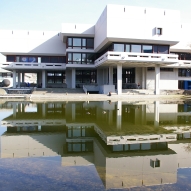| Dokumentenart: | Artikel | ||||||
|---|---|---|---|---|---|---|---|
| Titel eines Journals oder einer Zeitschrift: | Biology of Blood and Marrow Transplantation | ||||||
| Verlag: | Elsevier | ||||||
| Band: | 20 | ||||||
| Nummer des Zeitschriftenheftes oder des Kapitels: | 5 | ||||||
| Seitenbereich: | S. 640-645 | ||||||
| Datum: | Mai 2014 | ||||||
| Institutionen: | Medizin > Institut für Funktionelle Genomik > Lehrstuhl für Funktionelle Genomik (Prof. Oefner) Medizin > Lehrstuhl für Innere Medizin III (Hämatologie und Internistische Onkologie) Medizin > Institut für Funktionelle Genomik > Lehrstuhl für Statistische Bioinformatik (Prof. Spang) Informatik und Data Science > Lehrstuhl für Statistische Bioinformatik (Prof. Spang) | ||||||
| Identifikationsnummer: |
| ||||||
| Stichwörter / Keywords: | Clinical allogeneic transplantation; GVHD; Metagenomics; Microbiome | ||||||
| Dewey-Dezimal-Klassifikation: | 500 Naturwissenschaften und Mathematik > 500 Naturwissenschaften 500 Naturwissenschaften und Mathematik > 570 Biowissenschaften, Biologie 600 Technik, Medizin, angewandte Wissenschaften > 610 Medizin | ||||||
| Status: | Veröffentlicht | ||||||
| Begutachtet: | Ja, diese Version wurde begutachtet | ||||||
| An der Universität Regensburg entstanden: | Zum Teil | ||||||
| Dokumenten-ID: | 30496 |
Zusammenfassung
Next-generation sequencing of the hypervariable V3 region of the 16s rRNA gene isolated from serial stool specimens collected from 31 patients receiving allogeneic stem cell transplantation (SCT) was performed to elucidate variations in the composition of the intestinal microbiome in the course of allogeneic SCT. Metagenomic analysis was complemented by strain-specific enterococcal PCR and ...

Zusammenfassung
Next-generation sequencing of the hypervariable V3 region of the 16s rRNA gene isolated from serial stool specimens collected from 31 patients receiving allogeneic stem cell transplantation (SCT) was performed to elucidate variations in the composition of the intestinal microbiome in the course of allogeneic SCT. Metagenomic analysis was complemented by strain-specific enterococcal PCR and indirect assessment of bacterial load by liquid chromatography-tandem mass spectrometry of urinary indoxyl sulfate. At the time of admission, patients showed a predominance of commensal bacteria. After transplantation, a relative shift toward enterococci was observed, which was more pronounced under antibiotic prophylaxis and treatment of neutropenic infections. The shift was particularly prominent in patients that developed subsequently or suffered from active gastrointestinal (GI) graft-versus-host disease (GVHD). The mean proportion of enterococci in post-transplant stool specimens was 21% in patients who did not develop GI GVHD as compared with 46% in those that subsequently developed GI GVHD and 74% at the time of active GVHD. Enterococcal PCR confirmed predominance of Enterococcus faecium or both E. faecium and Enterococcus faecalis in these specimens. As a consequence of the loss of bacterial diversity, mean urinary indoxyl sulfate levels dropped from 42.5 ± 11 μmol/L to 11.8 ± 2.8 μmol/L in all post-transplant samples and to 3.5 ± 3 μmol/L in samples from patients with active GVHD. Our study reveals major microbiome shifts in the course of allogeneic SCT that occur in the period of antibiotic treatment but are more prominent in association with GI GVHD. Our data indicate early microbiome shifts and a loss of diversity of the intestinal microbiome that may affect intestinal inflammation in the setting of allogeneic SCT.
Metadaten zuletzt geändert: 29 Sep 2021 07:40



 Altmetric
Altmetric